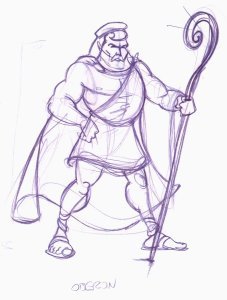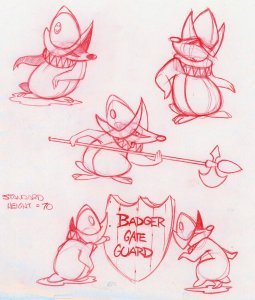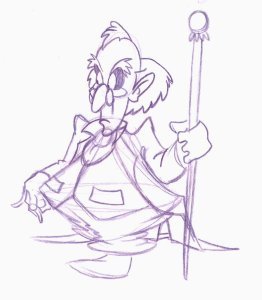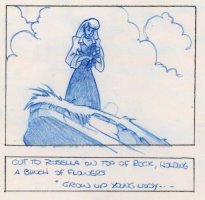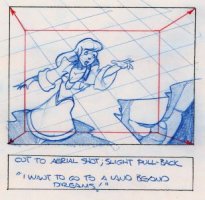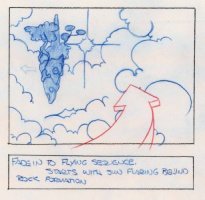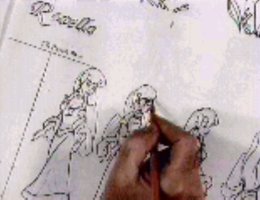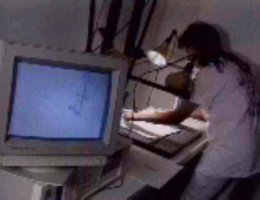King's Quest VII:
The Princeless Bride
Development history
With the success
of King's Quest VI: To Heir is Human, it was obvious that the King's
Quest series still was Sierra's flagship. With the new and exciting possibilities
opened up by the multimedia revolution, Roberta finally saw the possibility
to design the kind of games she had already dreamed of for a long time.
This would become her most busy period ever at Sierra, because she decided
to develop two games in parallel, each one of a scale Sierra had not ever
tried before. Her pet project was Phantasmagoria, a game she had
already wanted to do for several years. The design of Phantasmagoria
was incredibly ambitious and required huge investments for Sierra. Although
overshadowed by this project, the other game- King's Quest VII-
required a lot of resources as well. Right from the beginning, Roberta
was concerned about how the series could stay alive and fresh. She wanted
King's Quest VII to take a new approach and not become just another
sequel.
That approach
would be to make the game much more light-heared and cartoony than previous
King's Quest games. Roberta was always inspired by the Disney movies, and
wanted the next King's Quest game to be like them. With multimedia technology
becoming the standard, movie-quality animation could finally be used in
games. The whole gaming industry was looking at the movie industry for
inspiration at the time. Phantasmagoria was going to use live actors
and sets. But the same approach was not going to fit the King's Quest universe,
as it was much more about fantasy and imagination and would be limited
by the use of full-motion video.
With the rapid
increase in computer sales it was also obvious that the market of novice
computer users was expanding, and to grab hold of that market, King's
Quest VII needed to be easy to play. Roberta devised a simplified interface
with only one mouse cursor for all actions instead of the multiple action
cursor system invented for King's Quest V. The cursor would flash
whenever moved over an interesting area on the screen. This would simplify
interaction with the game so much that even young children could easily
understand it, and the cartoony approach was already bound to attract more
children to the series. This new interface would later receive a lot of
criticism for the way it reduced the user interaction to simply clicking
on everything interesting on the screen without thinking much about how
to interact with the game world to solve puzzles. However, the simplistic
interface certainly made the game design easier. The same type of interface
was used for Phantasmagoria. Both games would run on the new, multimedia-friendly,
32 bit version of Sierra's SCI interpreter: SCI-32. One of the features
of this interpreter was support for Super VGA graphics at a resolution
of 640x480 pixels.
 The
workload of two big game project at once was tough on Roberta, but she
wouldn't accept any of the games to suffer from too much attention on the
other. However, it was once again necessary with assistance, and this time
Roberta co-designed the game with Lorelei Shannon, who had previously
written the hint book for the King's Quest I remake and co-designed
Pepper's Adventures in Time with Jane Jensen, co-writer of
King's Quest VI. This continued the tradition of using King's Quest
to train new game designers. Lorelei would later design the sequel to Phantasmagoria,
which Roberta had no part in. Working out of Sierra's new Bellevue offices,
Roberta and Lorelei created the story and characters for the game, a process
which featured a lot of crazy ideas that sometimes ended up in the game
and sometimes not. The approach was to create a game full of wacky humor
and cartoony characters, and no idea was too wild to consider. This time,
there would be not only one, but two main characters. This was not
a new idea in adventure games, but it was the first time it was used in
the King's Quest series. The characters would be Princess Rosella and,
for the first time, Queen Valanice. Having female leads was not a controversial
decision anymore, as Roberta had already proven that it was a successful
concept in her previous games King's Quest IV and Colonel's Bequest.
As the game would reach a new audience as well and not only old King's
Quest fans, it was necessary to make it work as a stand-alone game for
players who didn't know of the history of the characters from the previous
King's Quest games.
The
workload of two big game project at once was tough on Roberta, but she
wouldn't accept any of the games to suffer from too much attention on the
other. However, it was once again necessary with assistance, and this time
Roberta co-designed the game with Lorelei Shannon, who had previously
written the hint book for the King's Quest I remake and co-designed
Pepper's Adventures in Time with Jane Jensen, co-writer of
King's Quest VI. This continued the tradition of using King's Quest
to train new game designers. Lorelei would later design the sequel to Phantasmagoria,
which Roberta had no part in. Working out of Sierra's new Bellevue offices,
Roberta and Lorelei created the story and characters for the game, a process
which featured a lot of crazy ideas that sometimes ended up in the game
and sometimes not. The approach was to create a game full of wacky humor
and cartoony characters, and no idea was too wild to consider. This time,
there would be not only one, but two main characters. This was not
a new idea in adventure games, but it was the first time it was used in
the King's Quest series. The characters would be Princess Rosella and,
for the first time, Queen Valanice. Having female leads was not a controversial
decision anymore, as Roberta had already proven that it was a successful
concept in her previous games King's Quest IV and Colonel's Bequest.
As the game would reach a new audience as well and not only old King's
Quest fans, it was necessary to make it work as a stand-alone game for
players who didn't know of the history of the characters from the previous
King's Quest games.
But even with
the help from Lorelei, Roberta had to work very hard to develop both games
in parallel. She sacrificed much of her free time and personal life for
the sake of the games. She has mentioned that it was sometimes hard to
keep both games in her head at the same time, especially because they were
so radically different. But she always managed to give one of them full
attention at all of the critical moments.
Long-time Sierra
musician Mark Seibert was appointed as producer for King's Quest VII.
In the coming years he would be the producer of some of Sierra's biggest
games.
Once the story
and characters were developed, art director Andy Hoyos and animation director
Marc Hudgins could start development of the artistic style of King's
Quest VII. Marc did illustrations of all the characters in the game
to base the animation on.
The amount of
animation needed for the game could easily rival that of an animated feature
film, and Sierra did not have such in-house resources. They required the
help of several animation houses, and the in-house animation studio was
only used for some of the animation in chapter 6. Four animation houses
were contracted to do the rest:
-
Animation Magic
Inc. was an animation studio in St. Petersburg, Russia. They were given
the responsibilities of doing the global animations and the animation for
chapter 1.
-
Dungeon Ink
& Paint, based in South Carolina, did the animation for chapters
2, 3 and 5.
-
LA West Film
Production did the animation for chapters 4 and 6. They were based
in Croatia. The political situation in the area at the time never created
any problems though.
-
Animotion,
a New York studio, made some of the animation for chapter 5 and the opening
and closing movies.
Sierra was so
pleased with the performances of LA West Film Production and Animotion
that they later contracted them to do the animation in Torin's Passage
and Leisure Suit Larry 7: Love for Sail as well.
The animation
was done with traditional animation techniques, where the animation frames
are first drawn on paper and then scanned into computers where they were
submitted to a digital touch-up and coloring process.
Backgrounds were
painted in-house, and a novelty of the game was the use of backgrounds
bigger than the screen. When the player walked towards one of the sides
of the screen at some locations, the background would scroll in the opposite
direction, revealing more scenery. This was another part in the effort
to make the game more cinematic.
The inventory
system also featured a novelty. All inventory objects were rendered in
3D and could be rotated by the user. This feature was utilized to make
some of the inventory objects reveal important details that could only
be discovered by close examination. All of the 3D artwork was done in-house
at Sierra.
The voice acting,
directed by Lorelei Shannon, featured a cast of professional voice actors.
Although they were less famous than the King's Quest VI cast, going
back to amateur voice acting like in King's Quest V was out of the
question. The music was composed by four of Sierra's composers: Jay Usher,
Neal Grandstaff, Dan Kehler and the producer Mark Seibert. Although moving
towards full multimedia, the music still needed to be done with traditional
synthesizer technology to make the game fit on one CD and run smoothly.
The music was best suited for the Roland Sound Canvas, but support for
General MIDI was naturally implemented.
A sneak preview
of the game was released with the 15th Anniversary release The King's
Quest Collection.
King's Quest
VII: The Princeless Bride
was released in November 1994 and ended up as a much-awaited Christmas
present in many homes. Shipped on CD only, it set pretty bold system requirements.
Deals with computer manufacturers like Compaq made King's Quest
VII ship together with many new multimedia computers to show off the
possibilities opened up by CD-ROM drives and digital sound cards. Much
like with Cyan's mega-hit Myst, this made the game reach
many people who would not have discovered it otherwise, and King's Quest
VII sold very well, boosting the total sales figure of the series to
over 3 million copies. In 1995, Sierra released a second version of the
game with full support for Microsoft's much-awaited Windows 95.
Back
to King's Quest VII: The Princeless Bride - Main page
Back
to The King's Quest games - Main page
Back
to The King's Quest Chronicles - Main page
 The
workload of two big game project at once was tough on Roberta, but she
wouldn't accept any of the games to suffer from too much attention on the
other. However, it was once again necessary with assistance, and this time
Roberta co-designed the game with Lorelei Shannon, who had previously
written the hint book for the King's Quest I remake and co-designed
Pepper's Adventures in Time with Jane Jensen, co-writer of
King's Quest VI. This continued the tradition of using King's Quest
to train new game designers. Lorelei would later design the sequel to Phantasmagoria,
which Roberta had no part in. Working out of Sierra's new Bellevue offices,
Roberta and Lorelei created the story and characters for the game, a process
which featured a lot of crazy ideas that sometimes ended up in the game
and sometimes not. The approach was to create a game full of wacky humor
and cartoony characters, and no idea was too wild to consider. This time,
there would be not only one, but two main characters. This was not
a new idea in adventure games, but it was the first time it was used in
the King's Quest series. The characters would be Princess Rosella and,
for the first time, Queen Valanice. Having female leads was not a controversial
decision anymore, as Roberta had already proven that it was a successful
concept in her previous games King's Quest IV and Colonel's Bequest.
As the game would reach a new audience as well and not only old King's
Quest fans, it was necessary to make it work as a stand-alone game for
players who didn't know of the history of the characters from the previous
King's Quest games.
The
workload of two big game project at once was tough on Roberta, but she
wouldn't accept any of the games to suffer from too much attention on the
other. However, it was once again necessary with assistance, and this time
Roberta co-designed the game with Lorelei Shannon, who had previously
written the hint book for the King's Quest I remake and co-designed
Pepper's Adventures in Time with Jane Jensen, co-writer of
King's Quest VI. This continued the tradition of using King's Quest
to train new game designers. Lorelei would later design the sequel to Phantasmagoria,
which Roberta had no part in. Working out of Sierra's new Bellevue offices,
Roberta and Lorelei created the story and characters for the game, a process
which featured a lot of crazy ideas that sometimes ended up in the game
and sometimes not. The approach was to create a game full of wacky humor
and cartoony characters, and no idea was too wild to consider. This time,
there would be not only one, but two main characters. This was not
a new idea in adventure games, but it was the first time it was used in
the King's Quest series. The characters would be Princess Rosella and,
for the first time, Queen Valanice. Having female leads was not a controversial
decision anymore, as Roberta had already proven that it was a successful
concept in her previous games King's Quest IV and Colonel's Bequest.
As the game would reach a new audience as well and not only old King's
Quest fans, it was necessary to make it work as a stand-alone game for
players who didn't know of the history of the characters from the previous
King's Quest games.
